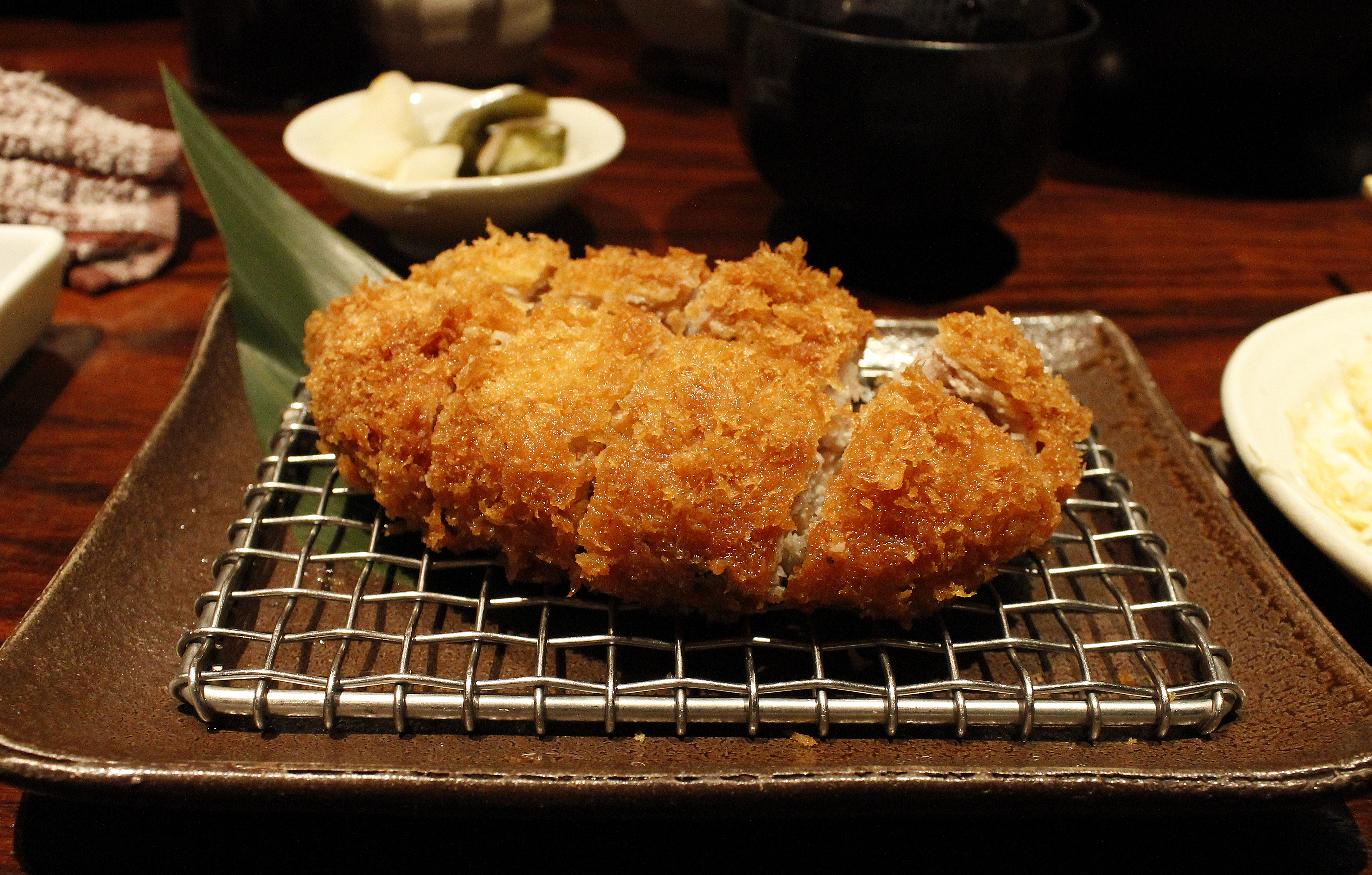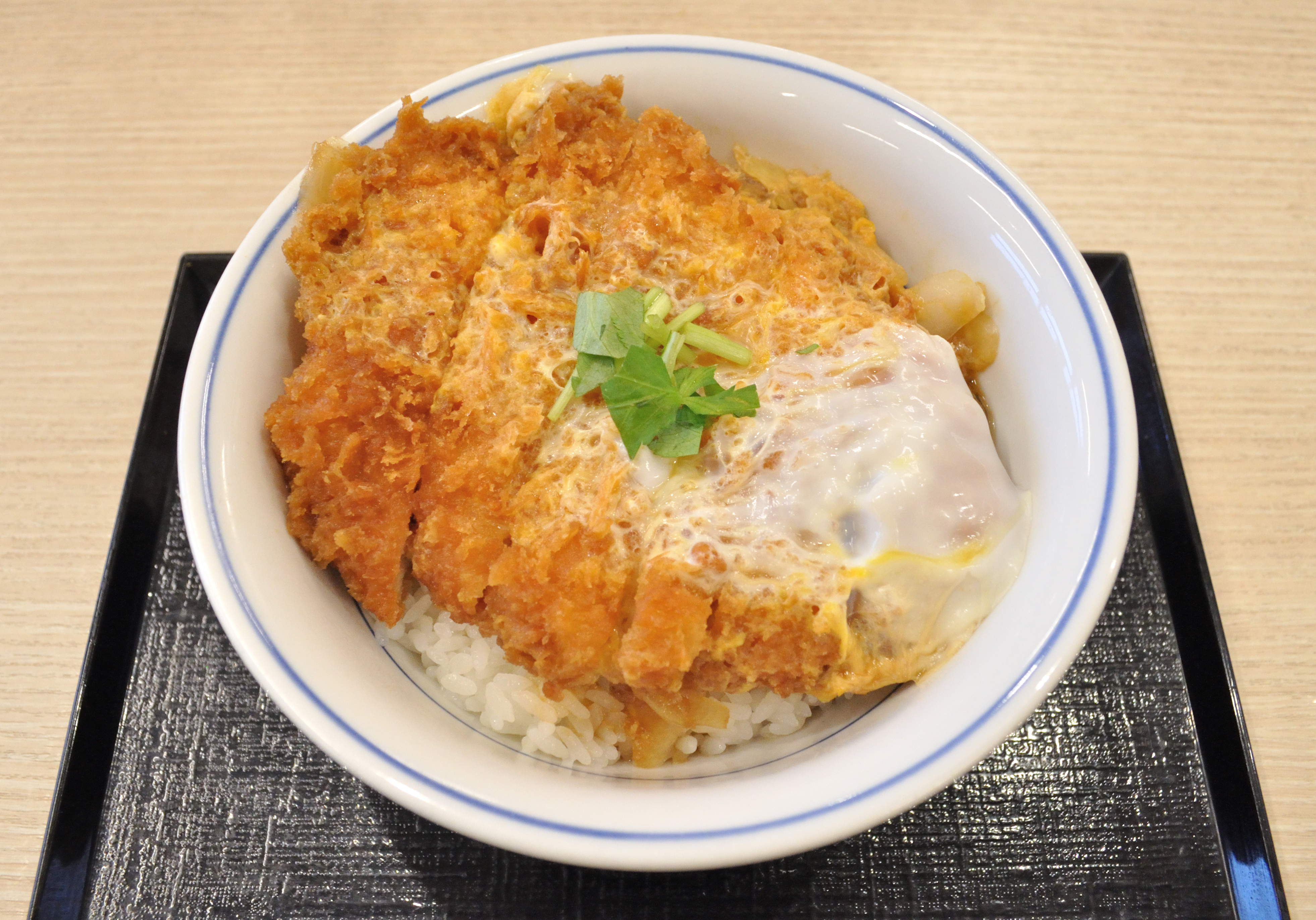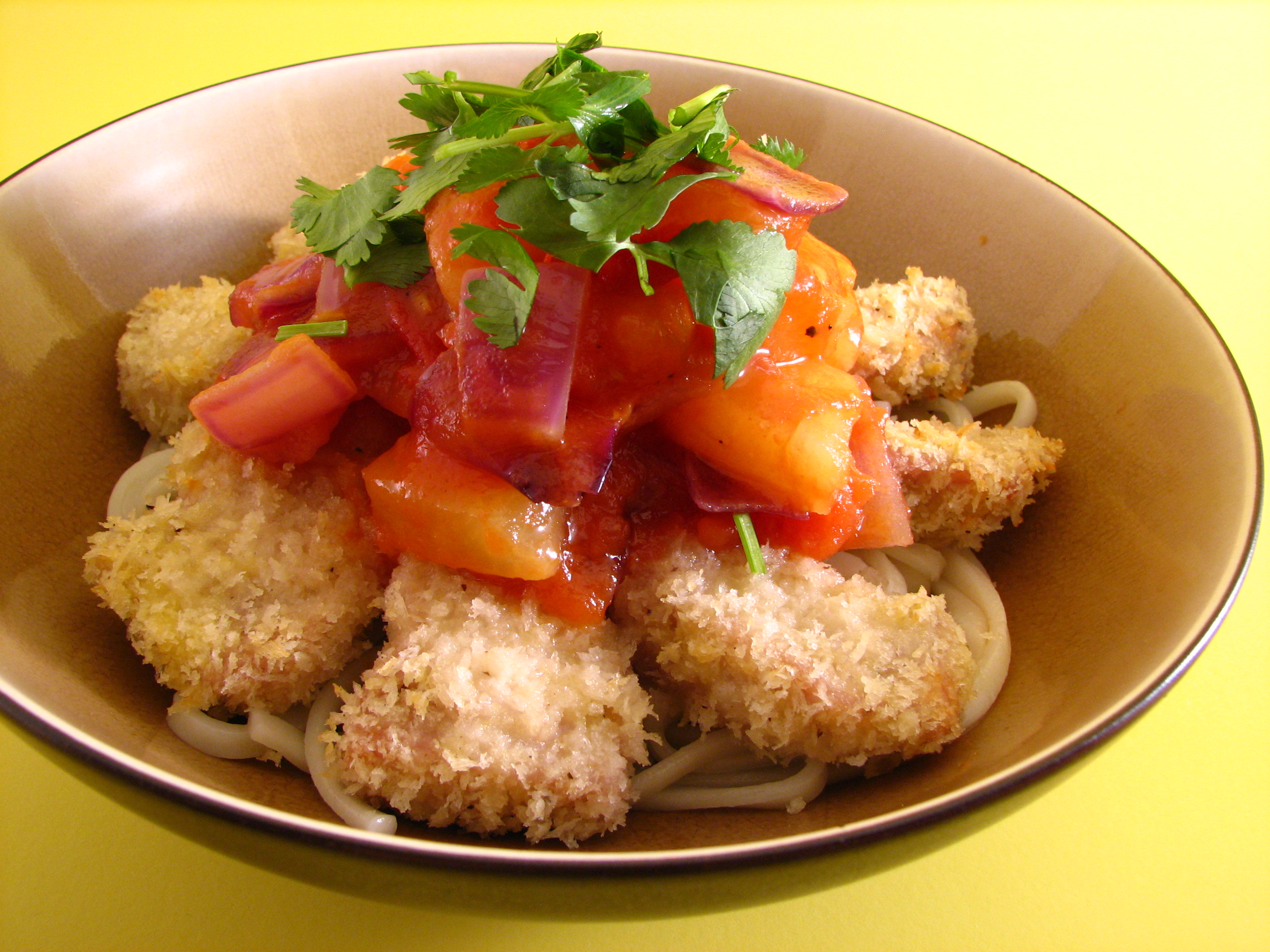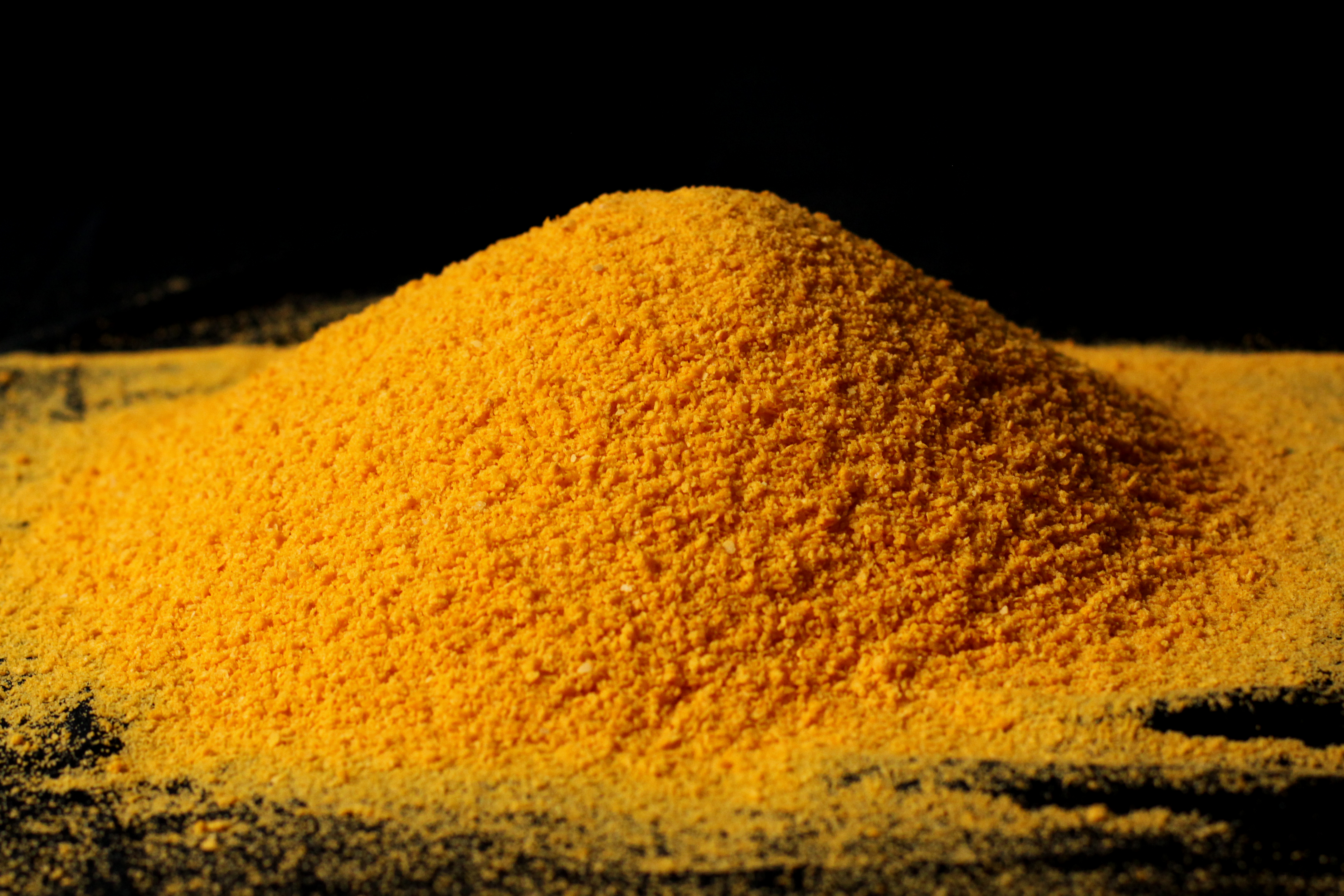|
Tonkatsu
is a Japanese dish that consists of a breaded, deep-fried pork cutlet. It involves coating slices of pork with panko (bread crumbs), and then frying them in oil. The two main types are fillet and loin. Tonkatsu is also the basis of other dishes such as '' katsukarē'' and '' katsudon''. Etymology The word ''tonkatsu'' is a combination of the Sino-Japanese word ''ton'' () meaning "pig", and ''katsu'' (), which is a shortened form of ''katsuretsu'' (), an old transliteration of the English word '' cutlet.'' History Tonkatsu originated in Japan during the Meiji Era in the late 19th century, a dish derived from European-style breaded and fried meat cutlets. European katsuretsu (loanword/ gairaigo for cutlet) was usually made with beef; the pork version was created in 1899 at a restaurant serving European-style foods, named Rengatei in Tokyo, Japan. It's a type of yōshoku — Japanese versions of European cuisine invented in the late 19th and early 20th centuries — a ... [...More Info...] [...Related Items...] OR: [Wikipedia] [Google] [Baidu] |
Tonkatsu Japan - 2014 12 12
is a Japanese dish that consists of a breaded, deep-fried pork cutlet. It involves coating slices of pork with panko (bread crumbs), and then frying them in oil. The two main types are fillet and loin. Tonkatsu is also the basis of other dishes such as '' katsukarē'' and ''katsudon''. Etymology The word ''tonkatsu'' is a combination of the Sino-Japanese word ''ton'' () meaning "pig", and ''katsu'' (), which is a shortened form of ''katsuretsu'' (), an old transliteration of the English word ''cutlet.'' History Tonkatsu originated in Japan during the Meiji Era in the late 19th century, a dish derived from European-style breaded and fried meat cutlets. European katsuretsu (loanword/gairaigo for cutlet) was usually made with beef; the pork version was created in 1899 at a restaurant serving European-style foods, named Rengatei in Tokyo, Japan. It's a type of yōshoku — Japanese versions of European cuisine invented in the late 19th and early 20th centuries — and was ... [...More Info...] [...Related Items...] OR: [Wikipedia] [Google] [Baidu] |
Tonkatsu Sauce
Tonkatsu sauce is a thick sauce served with tonkatsu (Japanese pork cutlet). It is a thick (viscosity over 2.0 pascal-second, per JAS Standard) Japanese Worcestershire-type sauce. It is similar to a brown sauce, and can include a fish sauce, tomatoes, prunes, dates, apples, lemon juice, carrots, onions, and celery among its ingredients. The first tonkatsu sauce was made in 1948 by Oliver Sauce Co., Ltd. of Hyogo Prefecture. The Bull-Dog brand of tonkatsu sauce, for example, is made from malt vinegar, yeast, and vegetable and fruit purees, pastes, and extracts. In the United States, Kikkoman brand sells a fruity tonkatsu sauce with applesauce as the main ingredient. See also * Soy sauce Soy sauce (also called simply soy in American English and soya sauce in British English) is a liquid condiment of Chinese origin, traditionally made from a fermented paste of soybeans, roasted grain, brine, and ''Aspergillus oryzae'' or '' As ... * Tare sauce * Japanese mayonnaise ... [...More Info...] [...Related Items...] OR: [Wikipedia] [Google] [Baidu] |
Katsudon
is a popular Japanese food, a bowl of rice topped with a deep-fried breaded pork cutlet, egg, vegetables, and condiments. The dish takes its name from the Japanese words ''tonkatsu'' (for pork cutlet) and ''donburi'' (for ''rice bowl dish''). It has become a modern tradition for Japanese students to eat katsudon the night before taking a major test or school entrance exam. This is because "katsu" is a homophone of the verb , meaning "to win" or "to be victorious". It is also a trope in Japanese police films: that suspects will speak the truth with tears when they have eaten katsudon and are asked, "Did you ever think about how your mother feels about this?" Even nowadays, the gag of "We must eat katsudon while interrogating" is popular in Japanese films. However, , police will never actually feed suspects during interrogation. Preparation The tonkatsu for the katsudon dish is prepared by dipping the cutlet in flour, followed by egg, then dipping in panko breadcrumbs, and de ... [...More Info...] [...Related Items...] OR: [Wikipedia] [Google] [Baidu] |
Bread Crumbs
Bread crumbs or breadcrumbs (regional variants including breading and crispies) consist of crumbled bread of various dryness, sometimes with seasonings added, used for breading or crumbing foods, topping casseroles, stuffing poultry, thickening stews, adding inexpensive bulk to soups, meatloaves and similar foods, and making a crisp and crunchy covering for fried foods, especially breaded cutlets like tonkatsu and schnitzel. The Japanese variety of bread crumbs is called ''panko''. Types Dry Dry breadcrumbs are made from dry breads which have been baked or toasted to remove most remaining moisture, and may have a sandy or even powdery texture. Bread crumbs are most easily produced by pulverizing slices of bread in a food processor, using a steel blade to make coarse crumbs, or a grating blade to make fine crumbs. A grater or similar tool will also do. Fresh The breads used to make soft or fresh bread crumbs are not quite as dry, so the crumbs are larger and produce a ... [...More Info...] [...Related Items...] OR: [Wikipedia] [Google] [Baidu] |
Breaded
Bread crumbs or breadcrumbs (regional variants including breading and crispies) consist of crumbled bread of various dryness, sometimes with seasonings added, used for breading or crumbing foods, topping casseroles, stuffing poultry, thickening stews, adding inexpensive bulk to soups, meatloaves and similar foods, and making a crisp and crunchy covering for fried foods, especially breaded cutlets like tonkatsu and schnitzel. The Japanese variety of bread crumbs is called ''panko''. Types Dry Dry breadcrumbs are made from dry breads which have been baked or toasted to remove most remaining moisture, and may have a sandy or even powdery texture. Bread crumbs are most easily produced by pulverizing slices of bread in a food processor, using a steel blade to make coarse crumbs, or a grating blade to make fine crumbs. A grater or similar tool will also do. Fresh The breads used to make soft or fresh bread crumbs are not quite as dry, so the crumbs are larger and produce a ... [...More Info...] [...Related Items...] OR: [Wikipedia] [Google] [Baidu] |
Pork
Pork is the culinary name for the meat of the domestic pig (''Sus domesticus''). It is the most commonly consumed meat worldwide, with evidence of pig husbandry dating back to 5000 BCE. Pork is eaten both freshly cooked and preserved; curing extends the shelf life of pork products. Ham, gammon, bacon, and sausage are examples of preserved pork. Charcuterie is the branch of cooking devoted to prepared meat products, many from pork. Pork is the most popular meat in the Western world, particularly in Central Europe. It is also very popular in East and Southeast Asia ( Mainland Southeast Asia, Philippines, Singapore, and East Timor). The meat is highly prized in Asian cuisines, especially in Mainland China, for its fat content and texture. Some religions and cultures prohibit pork consumption, notably Islam and Judaism. History Pigs were domesticated in Mesopotamia around 13,000 BC. Charcuterie is the branch of cooking devoted to prepared meat products such ... [...More Info...] [...Related Items...] OR: [Wikipedia] [Google] [Baidu] |
Panko
Bread crumbs or breadcrumbs (regional variants including breading and crispies) consist of crumbled bread of various dryness, sometimes with seasonings added, used for breading or crumbing foods, topping casseroles, stuffing poultry, thickening stews, adding inexpensive bulk to soups, meatloaves and similar foods, and making a crisp and crunchy covering for fried foods, especially breaded cutlets like tonkatsu and schnitzel. The Japanese variety of bread crumbs is called ''panko''. Types Dry Dry breadcrumbs are made from dry breads which have been baked or toasted to remove most remaining moisture, and may have a sandy or even powdery texture. Bread crumbs are most easily produced by pulverizing slices of bread in a food processor, using a steel blade to make coarse crumbs, or a grating blade to make fine crumbs. A grater or similar tool will also do. Fresh The breads used to make soft or fresh bread crumbs are not quite as dry, so the crumbs are larger and produce a ... [...More Info...] [...Related Items...] OR: [Wikipedia] [Google] [Baidu] |
Yōshoku
In Japanese cuisine, refers to a style of Western-influenced cooking which originated during the Meiji Restoration. These are primarily Japanized forms of European dishes, often featuring Western names, and usually written in katakana. It is an example of fusion cuisine. History At the beginning of the Meiji Restoration (1868 to 1912), national seclusion was eliminated and the Meiji Emperor declared Western ideas helpful for Japan's future progress. As part of the reforms, the Emperor lifted the ban on red meat and promoted Western cuisine, which was viewed as the cause of the Westerners' greater physical size. ''Yōshoku'' thus relies on meat as an ingredient, unlike the typical Japanese cuisine at the time. Additionally, many of the Westerners who started to live in Japan at that time refused to touch traditional Japanese food, and so their private Japanese chefs learned how to cook them Western-style cuisine, often with a Japanese spin. The first recorded print appearance ... [...More Info...] [...Related Items...] OR: [Wikipedia] [Google] [Baidu] |
Katsukarē
Katsu curry ( ja, カツカレー, katsukarē) is a Japanese dish consisting of a pork cutlet () served with a portion of Japanese rice and curry. It is served on a large plate and is typically eaten using a spoon or fork. The cutlet is usually precut into strips, eliminating the need for a knife. Generally eaten as a main course, the dish can be accompanied with water or miso soup. In Japan, there are fast-food restaurant chains which specialize in serving katsu curry, with varying meats and types of curry. The pork cutlet can be substituted with chicken. In Japan, the name refers exclusively to a dish of curry served with a cutlet. However, in the UK, the name is sometimes applied to any type of Japanese curry. History The dish is claimed to have originated at ''Ginza Swiss'' ( 銀座スイス), a restaurant in Ginza, Tokyo, in 1948. Yomiuri Giants player Shigeru Chiba , known by the stage name , is a Japanese actor, voice actor, talent and sound director from Kiku ... [...More Info...] [...Related Items...] OR: [Wikipedia] [Google] [Baidu] |
Katsu Curry By Luckypines
Katsu may refer to: Entertainment * Katsu (band), from Central Pennsylvania * KATSU!, manga by Mitsuru Adachi *" Katsu!" ( ja), a 1984 song by Shibugakitai *Katsucon, an annual anime convention in Maryland Other *Katsu (Zen), a shout used in East Asian Chan and Zen Buddhism, as well as in the martial arts *Deep fried cutlet in Japanese cuisine: ** Chicken katsu, fried chicken cutlet **Tonkatsu, fried pork cutlet **Katsudon, tonkatsu served in a bowl with rice ** Gyukatsu, fried beef cutlet * Kappo, resuscitation techniques also known as ''katsu'' People People named Katsu include: ;Surname * Alma Katsu (born 1959), American writer of adult fiction * Katsu Kaishu (Awa Katsu) (1823–1899), Japanese statesman and naval officer * Katsu Kokichi (1802–1850), Japanese samurai *Manami Katsu (born 1994), Japanese professional wrestler * Masanori Katsu (1879–1957), Japanese bureaucrat * Minami Katsu (born 1998), Japanese professional golfer *Shintaro Katsu (1931–1997), Japanese acto ... [...More Info...] [...Related Items...] OR: [Wikipedia] [Google] [Baidu] |
Cutlet
Cutlet (derived from French ''côtelette'', ''côte'', "rib") refers to: # a thin slice of meat from the leg or ribs of mutton, veal, pork or chicken # a dish made of such slice, often breaded (also known in various languages as a '' cotoletta'', '' Kotelett'', ''kotlet'' or ''kotleta'') # a croquette or cutlet-shaped patty made of ground meat # a kind of fish cut where the fish is sliced perpendicular to the spine, rather than parallel (as with fillets); often synonymous with steak # a prawn or shrimp with its head and outer shell removed, leaving only the flesh and tail # a mash of vegetables (usually potatoes) fried with bread History Cutlet were a typical starter in French cuisine, as a variation of Croquettes with a shape of small rib (''côtelette'' in French). The bone was simulated by a piece of fried bread or pasta. The recipe became popular in all Europe due to the influence of French cuisine. American and Canadian cuisines From the late 1700s until about 190 ... [...More Info...] [...Related Items...] OR: [Wikipedia] [Google] [Baidu] |
Cutlet
Cutlet (derived from French ''côtelette'', ''côte'', "rib") refers to: # a thin slice of meat from the leg or ribs of mutton, veal, pork or chicken # a dish made of such slice, often breaded (also known in various languages as a '' cotoletta'', '' Kotelett'', ''kotlet'' or ''kotleta'') # a croquette or cutlet-shaped patty made of ground meat # a kind of fish cut where the fish is sliced perpendicular to the spine, rather than parallel (as with fillets); often synonymous with steak # a prawn or shrimp with its head and outer shell removed, leaving only the flesh and tail # a mash of vegetables (usually potatoes) fried with bread History Cutlet were a typical starter in French cuisine, as a variation of Croquettes with a shape of small rib (''côtelette'' in French). The bone was simulated by a piece of fried bread or pasta. The recipe became popular in all Europe due to the influence of French cuisine. American and Canadian cuisines From the late 1700s until about 190 ... [...More Info...] [...Related Items...] OR: [Wikipedia] [Google] [Baidu] |









.jpg)